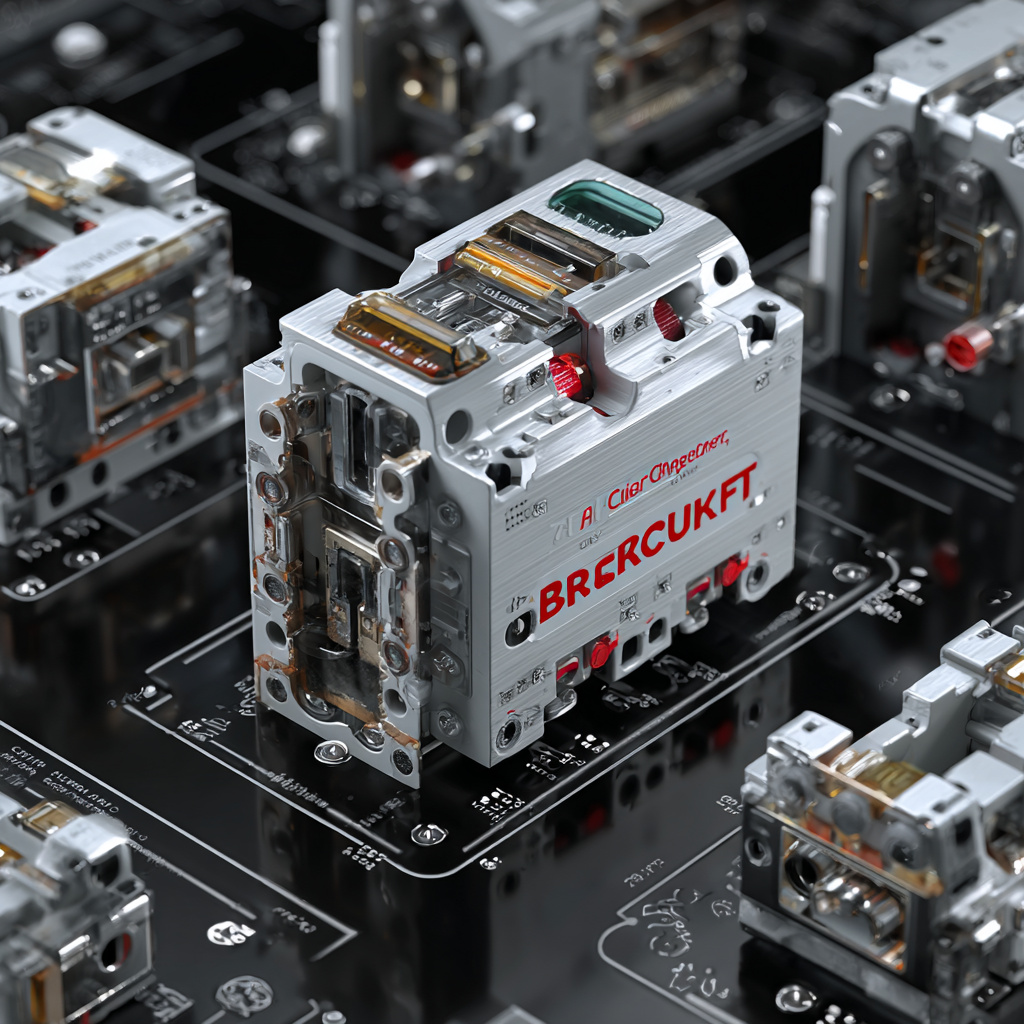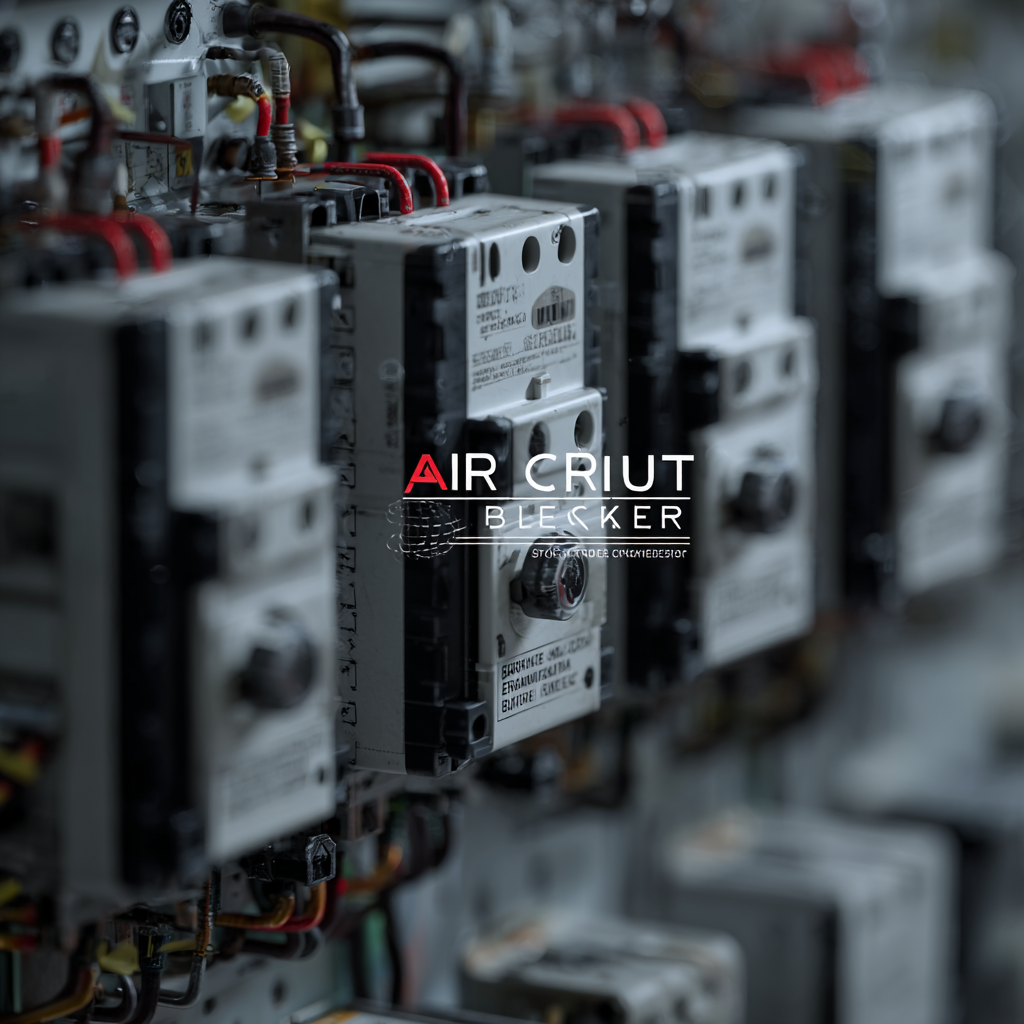
The Future of Innovative Energy Management with Best Air Circuit Breakers
In the rapidly evolving landscape of energy management, the role of Air Circuit Breakers (ACBs) has become pivotal in ensuring the efficiency and reliability of electrical systems. According to a recent report by MarketsandMarkets, the global air circuit breaker market is projected to reach USD 7.36 billion by 2024, growing at a CAGR of 5.5% from 2019. This growth is driven by the increasing demand for energy-efficient solutions and the need for advanced protective devices that can adapt to smart grid technologies. As industries strive for innovation, integrating ACBs with digital technologies presents a significant opportunity to enhance operational performance and safety. This blog will explore the future of energy management through the lens of ACBs, offering insights and tips on how businesses can leverage these advanced devices to optimize their energy usage and contribute to sustainable practices.

The Role of Best Air Circuit Breakers in Modern Energy Management Systems
Air Circuit Breakers (ACBs) play a crucial role in modern energy management systems, acting as essential components that ensure safety and efficiency in electrical networks. These devices not only protect electrical circuits from overloads and short circuits, but they also facilitate smoother integration of renewable energy sources into existing infrastructures. As organizations strive for sustainability, ACBs have become instrumental in managing energy flow, reducing waste, and optimizing the performance of energy systems.

Incorporating advanced technology, the best air circuit breakers are equipped with features that enhance real-time monitoring and control. They offer intelligent communication interfaces that allow systems to analyze energy consumption patterns and quickly respond to fluctuations. This adaptability is vital in today's rapidly changing energy landscape, where companies are increasingly focused on smart grids and automated energy management solutions. By ensuring reliable operation and maximizing efficiency, ACBs not only contribute to energy security but also align with global sustainability goals.
Key Features of Innovative Breakers Contributing to Energy Efficiency
The continuous evolution of technology has led to the development of innovative air circuit breakers (ACBs), which play a crucial role in energy management systems. These advanced breakers are designed with features that significantly enhance energy efficiency, making them indispensable in modern electrical installations. With the integration of smart technology, ACBs can monitor consumption patterns and adjust operational parameters in real-time, ensuring optimal energy use.
One of the key features contributing to energy efficiency is the low power loss characteristic of innovative ACBs. Unlike traditional breakers, these modern alternatives utilize advanced materials and designs to minimize energy loss during operation. Additionally, ACBs are equipped with fault detection capabilities that allow for rapid response in case of overloads or short circuits, reducing the risk of energy waste and enhancing system reliability. The incorporation of automated settings not only aids in preventive maintenance but also allows for more efficient load management, paving the way for smarter energy consumption in residential and industrial applications.
Furthermore, the environmental impact of energy usage is a pressing concern, and innovative ACBs address this by promoting sustainable practices. Their ability to integrate with renewable energy sources, such as solar and wind, ensures that more energy is harnessed and utilized effectively. With features like customizable settings for peak load management, these breakers empower users to make informed decisions about their energy consumption, leading to both cost savings and reduced environmental footprints.

How Digital Technologies Enhance the Functionality of Circuit Breakers
In today's rapidly evolving energy landscape, digital technologies play a transformative role in enhancing the functionality of circuit breakers. Advanced features such as real-time monitoring and predictive maintenance have become increasingly essential. According to a recent report by MarketsandMarkets, the smart circuit breakers market is projected to reach $10.3 billion by 2025, growing at a CAGR of 21.5%. This growth is largely driven by the integration of IoT and digital solutions that enable utilities and enterprises to optimize energy usage and improve grid reliability.
The integration of artificial intelligence (AI) and machine learning (ML) into air circuit breakers further enhances their efficiency. By analyzing vast amounts of operational data, these technologies can predict potential failures before they occur, reducing downtime and maintenance costs. A report from Research and Markets indicates that the application of AI in energy management could save businesses up to 30% on their operational costs, demonstrating the significant financial benefits of adopting these innovative technologies. As digital solutions continue to evolve, circuit breakers will not only act as protective devices but also as smart management tools that drive energy efficiency and sustainability.
The Future of Innovative Energy Management with Best Air Circuit Breakers - How Digital Technologies Enhance the Functionality of Circuit Breakers
| Feature | Traditional Circuit Breakers | Digital Circuit Breakers |
|---|---|---|
| Monitoring Capabilities | Basic status indicators | Real-time monitoring and analytics |
| Control Mechanism | Manual operation | Automated remote control with AI |
| Response Time | Milliseconds | Microseconds with predictive algorithms |
| Data Integration | Siloed data | Integrated with smart grid technologies |
| User Interface | Physical panel | User-friendly mobile and web applications |
| Energy Efficiency | Standard efficiency | Enhanced efficiency through real-time adjustments |
Sustainable Energy Solutions Enabled by Advanced Circuit Breaker Design
As the demand for sustainable energy solutions continues to rise, advanced circuit breaker designs are playing a pivotal role in the management of innovative energy systems. Today's best air circuit breakers are engineered not only to enhance operational efficiency but also to ensure safety and reliability in various applications. These breakers are essential for integrating renewable energy sources into existing power grids while minimizing energy losses and maximizing performance.
Tip: When selecting air circuit breakers, consider those with built-in smart technologies that allow for real-time monitoring and diagnostics. This capability can lead to timely maintenance and improved energy efficiency.
Moreover, the design advancements in circuit breakers enable better load management and energy distribution. By utilizing state-of-the-art materials and engineering techniques, these devices can handle higher capacities and operate under more demanding conditions. Their adaptability makes them ideal for both residential and industrial energy systems focused on sustainability.
Tip: It's advisable to conduct a thorough evaluation of your energy needs to determine the appropriate circuit breaker size and specifications, ensuring optimal performance and longevity in energy management solutions.
The Future of Innovative Energy Management
This chart illustrates the increasing trend in energy savings achieved by advanced circuit breaker designs over the years. As technology evolves, the efficiency and sustainability of energy management improve significantly.
The Future of Smart Grids: Integrating Air Circuit Breakers for Enhanced Performance
The emergence of smart grids represents a transformative shift in the way energy is managed and distributed. At the heart of this evolution lies the integration of advanced technologies, particularly air circuit breakers (ACBs). These intelligent devices not only enhance the reliability and efficiency of electrical systems but also contribute to the overall resilience of smart grids. ACBs are designed to respond dynamically to changes in load and environmental conditions, providing real-time protection and minimizing downtime, which is essential for maintaining an uninterrupted power supply.
Moreover, the synergy between ACBs and smart grid technologies facilitates improved energy management. Equipped with communication capabilities, ACBs can relay crucial data about energy consumption and system performance, enabling utilities to optimize resource allocation and reduce operational costs. This integration allows for a more responsive energy framework that accommodates renewable energy sources and supports demand-side management strategies.
As we look to the future, the role of ACBs in smart grids will be pivotal in creating sustainable and efficient energy systems, ultimately paving the way for innovative energy management practices that benefit both providers and consumers alike.

 JCB1-125
JCB1-125 JCB2-40M
JCB2-40M JCB3-63DC
JCB3-63DC JCB3-80H
JCB3-80H JCB3-80M
JCB3-80M JCBH-125
JCBH-125 JC125-4P
JC125-4P JCMX
JCMX JCSD
JCSD JCOF
JCOF JCMX1-125
JCMX1-125 JCOF1-125
JCOF1-125 JCSD1-125
JCSD1-125 JCR3HM
JCR3HM JCRD2-125
JCRD2-125 JCRD4-125
JCRD4-125 JCRB2-100
JCRB2-100 JC3RH-2P
JC3RH-2P JC3RH-S
JC3RH-S JC3RH-B
JC3RH-B JC3RH-BS
JC3RH-BS JCR2-63
JCR2-63 JCR1-40
JCR1-40 JCB2LE-80M
JCB2LE-80M JCB2LE-80M
JCB2LE-80M JCB2LE-80M
JCB2LE-80M JCB2LE-40M
JCB2LE-40M JCB1LE-125
JCB1LE-125 JCB3LM-80
JCB3LM-80 JCH2-125
JCH2-125 JCH2-125
JCH2-125 CJX2
CJX2 CJ19
CJ19 JCMCU
JCMCU JCHA
JCHA JCSD-40
JCSD-40 JCSD-60
JCSD-60 JCSP-40
JCSP-40 JCSP-60
JCSP-60 JCSPV
JCSPV WEW1-1000
WEW1-1000 WEW1-1600
WEW1-1600 WEW1-2000
WEW1-2000 WEW1-3200
WEW1-3200 WEW1-4000
WEW1-4000 WEW1-6300
WEW1-6300 DC6-125
DC6-125 AX-400-1250
AX-400-1250 AXAL-400-1250A
AXAL-400-1250A AL-400-1250
AL-400-1250 DC3-160
DC3-160 AXS-400-1250A
AXS-400-1250A SHT-125-160
SHT-125-160 UVT-125-160A
UVT-125-160A P-250A-3P-A
P-250A-3P-A 400-3P/4P terminal cover
400-3P/4P terminal cover 1250-3Pmccb accessories busbar
1250-3Pmccb accessories busbar 250-3P terminal conver
250-3P terminal conver WLM6-TCV-160A-3P
WLM6-TCV-160A-3P WLM6-MIP-250A
WLM6-MIP-250A WLM6-125A-3300 3P/4P
WLM6-125A-3300 3P/4P WLM6-160A-3300 3P/4P
WLM6-160A-3300 3P/4P WLM6-250A-3300 3P/4P
WLM6-250A-3300 3P/4P WLM6-400A-3300 3P/4P
WLM6-400A-3300 3P/4P WLM6-630A-3300 3P/4P
WLM6-630A-3300 3P/4P WLM6-800A-3300 3P/4P
WLM6-800A-3300 3P/4P WLM6-1250A-3300 3P/4P
WLM6-1250A-3300 3P/4P WLM6-1600A-3300 3P/4P
WLM6-1600A-3300 3P/4P WLM6-2000A 3P/4P
WLM6-2000A 3P/4P WLM8-125H-3300
WLM8-125H-3300 WLM8-250H-3300
WLM8-250H-3300 WLM8-400H-3300
WLM8-400H-3300 WLM8-400H-4300
WLM8-400H-4300 WLM8-630H-3300
WLM8-630H-3300 WLM8-630H-4300
WLM8-630H-4300 WLM6RT-125A
WLM6RT-125A WLM6RT-160A
WLM6RT-160A WLM6RT-250A
WLM6RT-250A WLM6RT-400A
WLM6RT-400A WLM6RT-630A
WLM6RT-630A WLM6RT-800A
WLM6RT-800A WLM6RT-1250A
WLM6RT-1250A WLM6E-160A-3300 3P
WLM6E-160A-3300 3P WLM6E-250A-3300
WLM6E-250A-3300 WLM6E-400A-3300 3P/4P
WLM6E-400A-3300 3P/4P WLM6E-630A-3300
WLM6E-630A-3300 WLM6E-800A-3300 3P/4P
WLM6E-800A-3300 3P/4P WLM6E-1250A-3300
WLM6E-1250A-3300 WLM6E-1600-3300 3P/4P
WLM6E-1600-3300 3P/4P WLM6E-2000A-3300 3P/4P
WLM6E-2000A-3300 3P/4P WLM8E-250H-3300
WLM8E-250H-3300 WLM8E-400H-3300
WLM8E-400H-3300 WLM8E-400H-4300
WLM8E-400H-4300 WLM8E-630H-3300
WLM8E-630H-3300 WLM8E-630H-4300
WLM8E-630H-4300 WLM6EY-250-3300 3P/4P
WLM6EY-250-3300 3P/4P WLM6EY-400 3P/4P
WLM6EY-400 3P/4P WLM6EY-630 3P/4P
WLM6EY-630 3P/4P WLM6EY-800A 3P/4P
WLM6EY-800A 3P/4P WLM6EY-1250A 3P/4P
WLM6EY-1250A 3P/4P WLM6ELY-160A
WLM6ELY-160A WLM6ELY-250A
WLM6ELY-250A WLM6ELY-400A
WLM6ELY-400A WLM6ELY-800A
WLM6ELY-800A WLM6ELY-1250A
WLM6ELY-1250A WLM8EY-250H-3300
WLM8EY-250H-3300 WLM8EY-400H-3300
WLM8EY-400H-3300 WLM8EY-630H-3300
WLM8EY-630H-3300 WLM6LY-125A
WLM6LY-125A WLM6L-160A
WLM6L-160A WLM6LY-250A
WLM6LY-250A WLM6LY-400A
WLM6LY-400A WLM6LY-800A
WLM6LY-800A WLM6LY-630A
WLM6LY-630A WLM6LY-1250A
WLM6LY-1250A WLM8LY-125H-3300
WLM8LY-125H-3300 WLM8LY-250H-3300
WLM8LY-250H-3300 WLM8LY-400H-3300
WLM8LY-400H-3300 WLM8LY-630H-3300
WLM8LY-630H-3300 JCB3-63DC
JCB3-63DC JCB1-125DC
JCB1-125DC WLM7DC-250A-2300 2P/3P
WLM7DC-250A-2300 2P/3P WLM7DC-315A-3300 2P/3P
WLM7DC-315A-3300 2P/3P WLM7DC-400A-2300 2P/3P
WLM7DC-400A-2300 2P/3P WLM7DC-630A-3300 3P
WLM7DC-630A-3300 3P WLM7DC-800A-2300 2P/3P
WLM7DC-800A-2300 2P/3P WLM7DC-400A 2300
WLM7DC-400A 2300 WLM7DC-630A-2300 2P
WLM7DC-630A-2300 2P WLM7HU-250-3300 3P
WLM7HU-250-3300 3P WLM7HU-315-3300 3P
WLM7HU-315-3300 3P WLM7HU-400-3300 3P
WLM7HU-400-3300 3P WLM7HU-630-3300 3P
WLM7HU-630-3300 3P WLM7HU-800-3300 3P
WLM7HU-800-3300 3P PV-1500V/250A
PV-1500V/250A WEW3-1600
WEW3-1600 WEW3-2500
WEW3-2500 WEW3-4000
WEW3-4000 WEW3-7500
WEW3-7500



